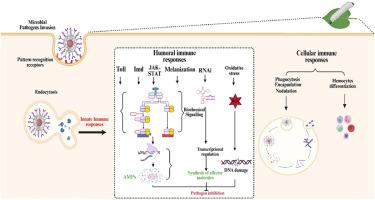家蚕体液免疫防御研究综述:对微生物病原体的机制和反应。
IF 2.4
3区 农林科学
Q1 FISHERIES
引用次数: 0
摘要
家蚕(Bombyx mori L.)是一种具有经济价值的昆虫,也是研究昆虫免疫的良好模型。它强大的先天免疫系统保护它免受许多病原体的侵害,如病毒、细菌、真菌和微孢子虫。先天免疫系统包括两种重叠的机制,即体液免疫系统和细胞免疫系统。它依赖于识别受体来区分病原体相关分子模式(PAMPs),这刺激了许多免疫应答途径,包括JAK- STAT, Toll, Imd和RNA干扰。本文综述了体液免疫反应,重点介绍了其关键成分,包括抗菌肽、酚氧化酶(PO)、模式识别受体(PRRs)、信号通路和体液效应分子。这些过程协同对抗和消灭传染性微生物,从而帮助蚕的免疫防御。扩大对体液免疫反应的认识是理解蚕和其他无脊椎动物先天免疫的分子基础和必需免疫因子的关键。此外,该研究为优化蚕丝生产方法、制定影响蚕丝产量的感染预防策略以及为未来昆虫免疫学研究提供理论框架提供了重要的前景。本文章由计算机程序翻译,如有差异,请以英文原文为准。

A Comprehensive review of humoral immune defense in the silkworm, Bombyx mori: Mechanistic insights and responses to microbial pathogens
The silkworm Bombyx mori L. is an economically valuable insect and an excellent model for investigating insect immunity. Its robust innate immune system shields it from numerous pathogens, such as viruses, bacteria, fungi, and microsporidia. The innate immune system comprises two overlapping mechanisms, known as the humoral and cellular immune systems. It depends on recognition receptors to distinguish the pathogen-associated molecular patterns (PAMPs), which stimulate numerous immunoresponsive pathways comprising JAK- STAT, Toll, Imd, and RNA interference. This review examines the humoral immune response, highlighting its critical components, including antimicrobial peptides, phenoloxidase (PO), pattern recognition receptors (PRRs), signaling pathways, and humoral effectors molecules. These processes synergistically counter and eradicate infectious microbes, thus aiding silkworms' immune defense. Expanding the understanding of humoral immune responses is key for comprehending molecular bases of innate immunity and essential immune elements distributed among silkworms and other invertebrates. Moreover, it could offer significant prospects for optimizing silk production methods, developing strategies for preventing infections affecting silk yield, and offering a theoretical framework for the future investigation of insect immunology.
求助全文
通过发布文献求助,成功后即可免费获取论文全文。
去求助
来源期刊
CiteScore
6.20
自引率
6.90%
发文量
206
审稿时长
49 days
期刊介绍:
Developmental and Comparative Immunology (DCI) is an international journal that publishes articles describing original research in all areas of immunology, including comparative aspects of immunity and the evolution and development of the immune system. Manuscripts describing studies of immune systems in both vertebrates and invertebrates are welcome. All levels of immunological investigations are appropriate: organismal, cellular, biochemical and molecular genetics, extending to such fields as aging of the immune system, interaction between the immune and neuroendocrine system and intestinal immunity.

 求助内容:
求助内容: 应助结果提醒方式:
应助结果提醒方式:


